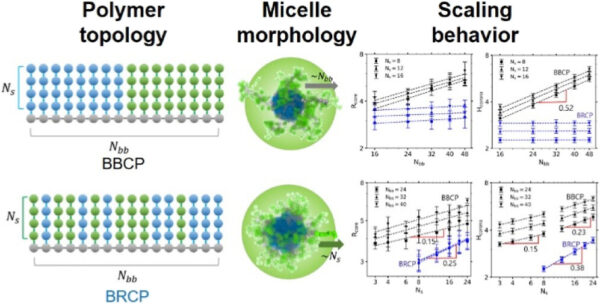“Scaling Behavior of Solution Self-Assembled Micelle of Sequence-Controlled Bottlebrush Copolymer” by Sangwoo Kwon, Jiyun Nam, Jae Wan Chung, Myungeun Seo, Won Bo Lee, and YongJoo Kim was published in Macromolecules. The Kim group at Korea University and the Lee group at Seoul National University led this simulation-driven work with Sangwoo Kwon as the first author. Jiyun, now at Colorado State University as a postdoc (as of 2024/9/16), participated in the work as a co-first author from our group. The paper can be found in the following link: https://pubs.acs.org/doi/10.1021/acs.macromol.4c00226

Collaboration between simulations and experiments is crucial as simulations offer detailed theoretical insights while experiments validate and refine these models, ensuring comprehensive understanding and practical applicability in material design. Previously, we demonstrated that a well-defined graft copolymer could be transformed into a core cross-linked star polymer with control of arm length, density, and spatial arrangement (see the previous post and the Macromolecules 2021 paper here). The Kim and Lee groups simulated the solution self-assembly of block and random graft copolymers by performing extensive dissipative particle dynamics (DPD) simulations. They found that the length scale of their micelles primarily depends on the length of the backbone and the side chain, respectively (so are the corresponding core cross-linked star polymers, as the spatial information is also transferred during the collapse).
In this work, they explored densely grafted bottlebrush copolymers, where every repeating unit of the backbone now consists of a side chain. The side chain is either solvophilic or solvophobic and arranged into block and random grafting sequences. The solvophobic interaction drives self-assembly in the solution. Based on the DPD simulations, the simulation team calculated the size and shape of the resulting micelles, the aggregation number, and the probability distribution of the backbone beads. They further decoupled the micelle size into core radius and corona thickness, which allowed a detailed quantitative analysis of these structures’ scaling behavior, including extraction of scaling exponents.
In essence, the scaling behavior is identical to the graft copolymer case: micelles formed from bottlebrush block copolymers show a backbone chain length scale predominantly influenced by the micelle size, while those from bottlebrush random copolymers exhibit a length scale dependent on side chain configuration. We synthesized model bottlebrush block copolymers of hydrophobic polylactide and hydrophilic poly(ethylene oxide) to compare the simulation results with experimental observation. Their hydrodynamic radii in water increased with the backbone length, and the scaling exponent was in good agreement with the value predicted by the simulation. We also took the micelle size information of random copolymers from the literature and found that it is very comparable to the simulation. This alignment underscores the importance of integrating simulations with experiments, as it enhances the accuracy and reliability of predictions about micelle behavior and guides future modifications in complex micelle design by controlling copolymer architecture.

